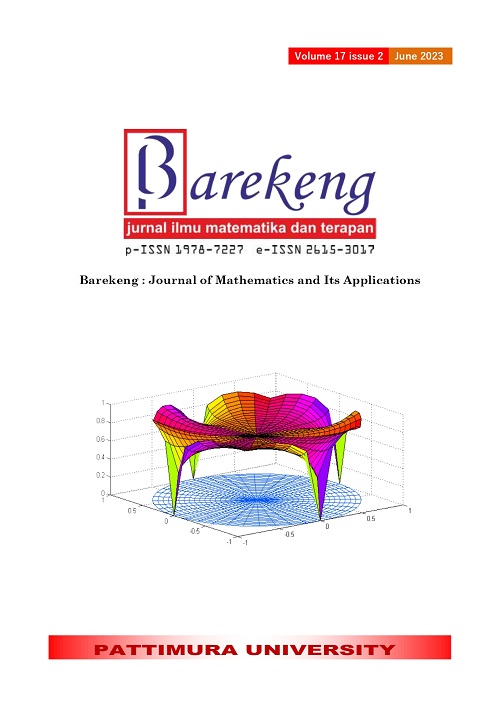TSUKAMOTO FUZZY IN OPTIMIZING THE CREDITWORTHINESS ASSESSMENT PROCESS AT SAVINGS AND LOAN COOPERATIVES
Abstract
Savings and Loan Cooperatives are ones of the non-bank institutions whose business activity is the provision of loan. In its business activities, problems often arise, namely non-performing loans which causes no turnover of funds which leads to losses. One of the causes of non-performing loans is the lack of objective creditworthiness assessment. The purpose of this study is to optimize the process of assessing the feasibility of loan applications at Savings and loan credit with assessment criteria: loan value, total income, loan term and collateral value. The tsukamoto fuzzy method was used in this study. Tsukamoto fuzzy method consists of four steps.: fuzzification, Forming fuzzy rules, application of implication functions using the MIN function and defuzzification using the weighted average calculation method. In this research, it was found that Tsukamoto's fuzzy method can be applied to the creditworthiness assessment process at the Saving and Credit Cooperatives. This is because the accuracy rate of the decision results from the tsukamoto method is 93.75%. A total of 60 data out of 64 data are in accordance with the eligibility decision at one of Saving and loan Cooperatives in West Java, Indonesia. Tsukamoto fuzzy method can optimize the credit assessment process in Savings and loan Cooperatives because the eligibility assessment process becomes more efficient and objective.
Downloads
References
BPS, Financial Institution Statistics 2021. Jakarta: Badan Pusat Statistik, 2022.
BPS, “Jumlah Koperasi Aktif Menurut Provinsi (Unit), 2019-2021,” 2021. https://www.bps.go.id/indicator/13/760/1/jumlah-koperasi-aktif-menurut-provinsi.html
Pemerintah Indonesia, “Undang-Undang Republik Indonesia Nomor 17 Tahun 2012 tentang Perkoperasian.” Jakarta, 2012.
BPS, Savings and Loan Cooperatives Statistics 2021. Jakarta: Badan Pusat Statistik, 2022.
M. B. A. Ismail, Manajeman Perbankan: Dari Teori Menuju Aplikasi. Kencana, 2018.
R. Dewi and Yuliana, “Analisis Faktor Internal dan Eksternal Terhadap Potensi Kredit Macet Pada Koperasi Simpan Pinjam di Ponorogo,” Universitas Muhammadiyah Ponorogo, 2021.
I. Ranggadara, “Fuzzy Tsukamoto and ITIL for Improvement Strategy on Incident Ticket Services,” International Journal of Innovative Technology and Exploring Engineering, vol. 8, no. 10, pp. 897–903, 2019.
A. T. Bon and S. F. Utami, “Applying fuzzy inference system tsukamoto for decision making in crude palm oil production planning,” Proceedings of the International Conference on Industrial Engineering and Operations Management, vol. 8-10 March, pp. 2206–2210, 2016.
U. Siahaan and A. Putera, “Implementation of Fuzzy Tsukamoto Algorithm in Determining Work Feasibility,” OSR Journal of Computer Engineering (IOSR-JCE), vol. 19, no. 4, pp. 52–55, 2017, doi: 10.9790/0661-1904045255.
E. Nugraha, A. P. Wibawa, M. L. Hakim, U. Kholifah, R. H. Dini, and M. R. Irwanto, “Implementation of fuzzy tsukamoto method in decision support system of journal acceptance,” J Phys Conf Ser, vol. 1280, no. 2, 2019, doi: 10.1088/1742-6596/1280/2/022031.
S. Kusumadewi and H. Purnomo, Aplikasi Logika Fuzzy untuk pendukung keputusan. Yogyakarta: Graha Ilmu, 2004.
J. J. Buckley and E. Eslami, An Introduction to Fuzzy Logic and Fuzzy Sets. Heidelberg: Physica-Verlag HD, 2002. doi: 10.1007/978-3-7908-1799-7.
G. Bodjaziev and M. Bodjaziev, Fuzzy Logic for Business, Finance, and Management. World Scientific Publishing Co. Pte. Ltd., 2007.
A. Kaur and A. Kaur, “Comparison of Mamdani-Type and Sugeno-Type Fuzzy Inference Systems for Air Conditioning System,” International Journal of Soft Computing & Engineering, vol. 2, no. 2, pp. 323–325, 2012.
T. J. Ross, Fuzzy Logic with Engineering Applications. Wiley, 2010. doi: 10.1002/9781119994374.
F. Ariani and R. Y. Endra, “Implementation of Fuzzy Inference System With Tsukamoto Method for Study Programme Selection,” International Conference on Engineering and Technology Development (ICETD), vol. 0, no. 0, Aug. 2013.
A. Kamsyakawuni, A. Riski, and A. B. Khumairoh, “APPLICATION FUZZY MAMDANI TO DETERMINE THE RIPENESS LEVEL OF CRYSTAL GUAVA FRUIT,” BAREKENG: Jurnal Ilmu Matematika dan Terapan, vol. 16, no. 3, pp. 1087–1096, Sep. 2022, doi: 10.30598/barekengvol16iss3pp1087-1096.
S. L. B. Ginting, M. R. M Rizky, Y. R. Ginting, and Sutono, “The Application of Fuzzy Logic Method in the Debtors Eligibility Assessment System of Microfinance Institution,” IOP Conf Ser Mater Sci Eng, vol. 879, no. 1, pp. 0–8, 2020, doi: 10.1088/1757-899X/879/1/012039.
Copyright (c) 2023 Tabah Heri Setiawan, Laras Prihatini

This work is licensed under a Creative Commons Attribution-ShareAlike 4.0 International License.
Authors who publish with this Journal agree to the following terms:
- Author retain copyright and grant the journal right of first publication with the work simultaneously licensed under a creative commons attribution license that allow others to share the work within an acknowledgement of the work’s authorship and initial publication of this journal.
- Authors are able to enter into separate, additional contractual arrangement for the non-exclusive distribution of the journal’s published version of the work (e.g. acknowledgement of its initial publication in this journal).
- Authors are permitted and encouraged to post their work online (e.g. in institutional repositories or on their websites) prior to and during the submission process, as it can lead to productive exchanges, as well as earlier and greater citation of published works.






1.gif)



